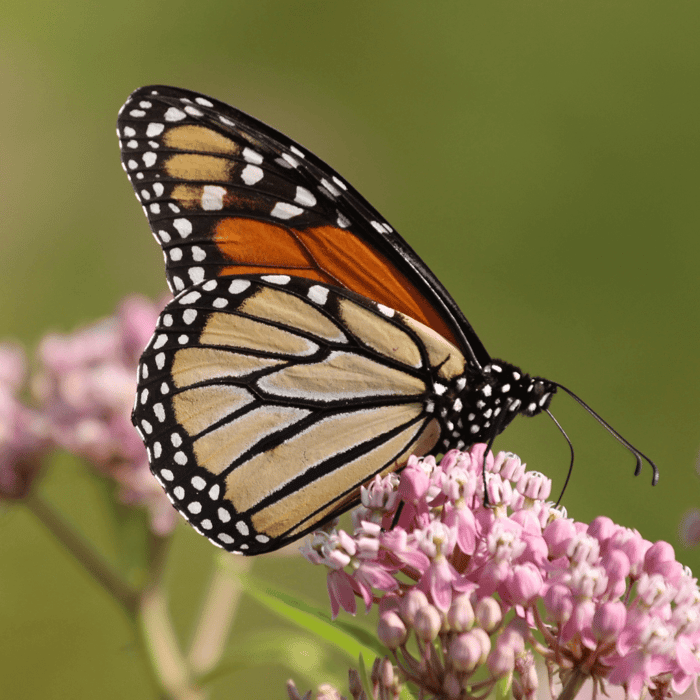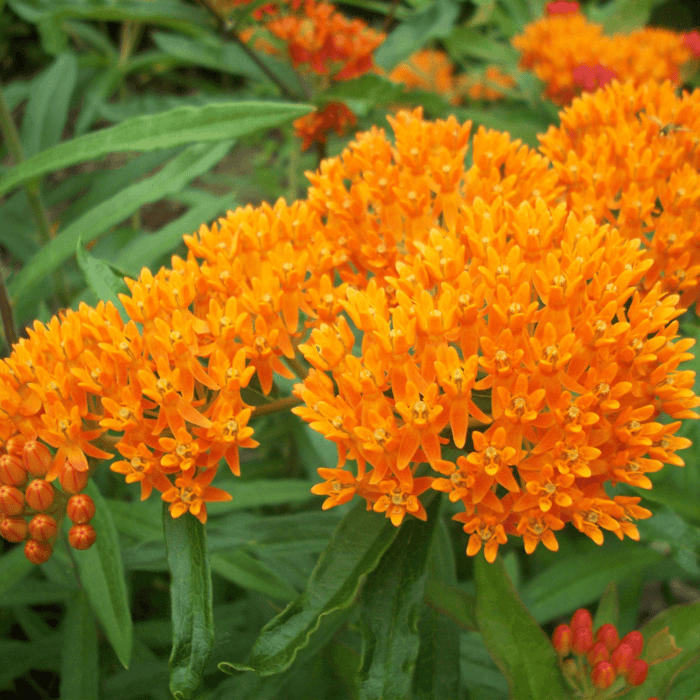Hi there, fellow gardeners! As an avid gardener, I'm always looking for ways to help our beautiful planet and its creatures. One of my favorite ways is by planting milkweed, which provides essential food and habitat for the beloved monarch butterfly. If you're wondering can I start milkweed seeds indoors, the answer is yes! In this in-depth article, we'll go through a step-by-step guide on how to do this, so you can enjoy beautiful milkweed plants and support our fluttery friends.
Why Grow Milkweed?
Milkweed plants are not only beautiful, but they also serve an important purpose. They are the sole source of food for monarch butterfly caterpillars, which makes them crucial for the survival of this beautiful species. There are many different milkweed species, including perennial milkweed and tropical milkweed, and each offers unique benefits for pollinators.
Growing milkweed can also benefit other pollinators, like bees and hummingbirds, that are attracted to the nectar-rich flowers. Furthermore, milkweed plants can help improve soil health, provide erosion control, and add a pop of color to your garden landscape.
Milkweed Species and Varieties
There are over 100 milkweed species native to North America, and each has its unique characteristics. Understanding the different types of milkweed can help you choose the best variety for your garden. Here are some popular milkweed species and varieties:
-
Common Milkweed (Asclepias syriaca): This perennial milkweed is native to the eastern United States and Canada. It has large, round clusters of pink or lavender flowers and can grow up to six feet tall.
-
Swamp Milkweed (Asclepias incarnata): This perennial milkweed prefers moist soil and is perfect for wetland or rain garden areas. It has attractive clusters of pink or white flowers and can grow up to five feet tall.
-
Butterfly Weed (Asclepias tuberosa): A perennial milkweed with bright orange flowers, butterfly weed is a favorite among gardeners for its vibrant color and ability to attract butterflies. It can grow up to three feet tall and prefers well-draining soil.
-
Showy Milkweed (Asclepias speciosa): Native to the western United States, showy milkweed has large, fragrant pink flowers that attract butterflies and hummingbirds. It can grow up to four feet tall and is tolerant of various soil types.
-
Tropical Milkweed (Asclepias curassavica): This non-native, annual milkweed is popular in warmer climates and is often grown as an annual in cooler areas. It has vibrant red and orange flowers and can grow up to four feet tall.
Milkweed Seeds For Monarch Butterflies | 4 Variety Pack
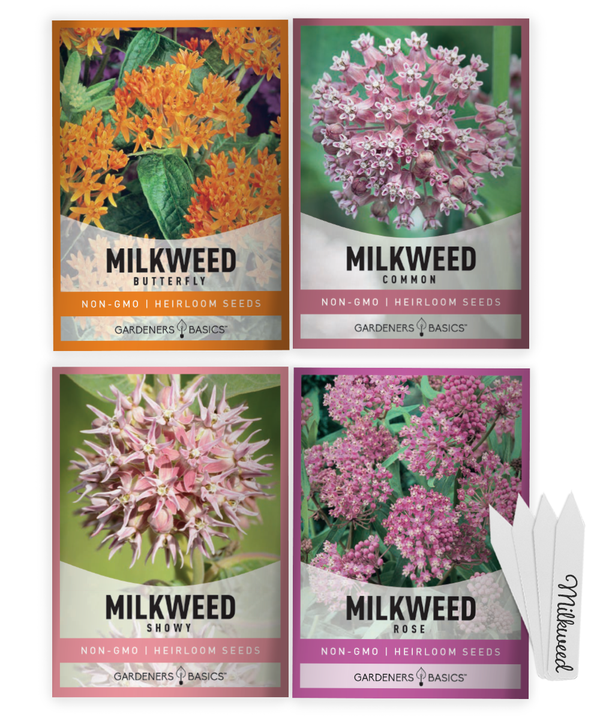
$9.95
Milkweed Seed Assortment For Planting – 4 Stunning Varieties to Attract Monarch Butterflies and Beautify Your Garden Transform your garden into a thriving paradise with our Milkweed Seed Assortment for Planting. This exclusive collection features four exquisite Milkweed varieties -… read more
Choosing Your Milkweed Seeds
Before starting your milkweed seeds indoors, it's essential to choose the right milkweed varieties for your region. You can find a wide range of milkweed seeds for sale at Gardeners Basics. We have a helpful guide on how to choose the right milkweed seeds based on your location and garden needs.
When selecting milkweed seeds, consider factors such as your garden's climate, soil type, available space, and desired aesthetics. It's also important to choose species that are native to your region to support local ecosystems and ensure the plants thrive in your garden.
Preparing Your Milkweed Seeds: Cold Stratification
Some milkweed species require cold stratification to improve their germination rate. Cold stratifying involves mimicking the natural winter conditions by exposing the seeds to a cold, moist environment for a specific period. This process helps break the seed's dormancy, resulting in a higher germination rate once planted. To cold stratify your milkweed seeds:
- Place your milkweed seeds in a plastic bag or container with a moistened paper towel or sand.
- Seal the bag or container and store it in the refrigerator for a minimum of 30 days. The exact duration depends on the milkweed species, so be sure to research the requirements for your chosen variety.
- Check on the seeds occasionally to ensure the paper towel or sand remains moist. Add water as needed to maintain consistent moisture levels.
- After the stratification period, remove the seeds from the refrigerator and let them return to room temperature before planting.
Please note that not all milkweed species require cold stratification. For instance, tropical milkweed seeds do not need this process, as they are native to warm climates.
Seed Starting: Sowing Your Milkweed Seeds Indoors
Now that your milkweed seeds are ready, it's time to plant them indoors. Starting your seeds indoors can help ensure a higher germination rate, provide a controlled environment for seedlings to grow, and allow you to extend the growing season by getting a head start on planting. Follow these steps to ensure successful germination:
- Fill seed trays or small pots with a high-quality seed-starting mix, leaving about 1/4 inch from the top. Seed-starting mixes are formulated to provide optimal conditions for seed germination and early seedling growth, so it's crucial to use a mix designed specifically for this purpose.
- Place one or two milkweed seeds on the surface of the soil in each cell or pot. Planting multiple seeds per cell or pot increases the likelihood of successful germination, as not all seeds may germinate.
- Gently press the seeds into the soil, ensuring they have good contact with the seed-starting mix. This helps the seeds absorb moisture from the soil and promotes germination.
- Lightly cover the seeds with a thin layer of soil or vermiculite. Vermiculite helps retain moisture, improves aeration, and promotes consistent germination conditions.
- Water the seeds gently, ensuring the soil remains moist but not waterlogged. A spray bottle or mister is ideal for this task, as it provides a gentle and even distribution of water.
- Place the seed trays or pots in a warm location, ideally between 65°F and 75°F. The ideal temperature for germination varies depending on the milkweed species, so be sure to research the specific requirements for your chosen variety. You can also place it on a heat mat to speed up this process (we love heat mats around here).
Showy Milkweed Seeds
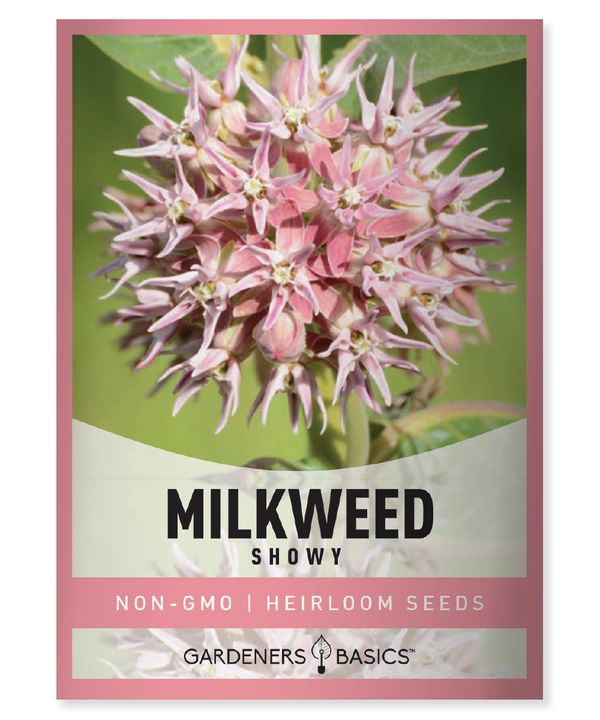
$2.49
Showy Milkweed Seeds – Heirloom, Non-GMO, Non-Hybrid, Open-Pollinated Transform your garden into a pollinator’s paradise with our Showy Milkweed seeds! These premium heirloom seeds are non-GMO, non-hybrid, and open-pollinated, making them ideal for gardeners seeking reliable, natural growth. Perfect for… read more
Maintaining Optimal Germination Conditions
To ensure the best germination rates for your milkweed seeds, it's essential to maintain optimal conditions throughout the germination process. Here are some tips to help you achieve this:
- Monitor the soil moisture regularly and water as needed to keep the soil consistently moist. Do not let the soil dry out, as this can hinder germination and cause the seedlings to wilt.
- Use a heat mat or place the seed trays in a warm area to maintain consistent soil temperatures. This is particularly important for tropical milkweed seeds, which require warmer temperatures for germination.
- Keep the seed trays or pots covered with a plastic dome or plastic wrap to help maintain humidity levels. High humidity is essential for successful germination, as it prevents the seeds from drying out. Remove the cover once the seedlings have emerged to prevent mold and promote airflow.
Providing Adequate Light for Your Milkweed Seedlings
As your milkweed seeds begin to germinate, they'll need plenty of light to grow strong and healthy. Adequate light is essential for the development of sturdy stems, healthy leaves, and robust root systems. If you don't have a sunny window that provides at least 6 hours of direct sunlight, consider using grow lights to ensure your seedlings receive adequate light.
- Set up your grow lights 6 to 12 inches above the seed trays or pots. The specific distance will depend on the type of grow lights you are using, so be sure to consult the manufacturer's recommendations.
- Keep the lights on for 14-16 hours per day, using a timer for consistency. This extended photoperiod mimics the long days of summer and promotes healthy, vigorous growth.
- As the seedlings grow, adjust the height of the grow lights to maintain the recommended distance. This ensures that your plants receive optimal light levels without being too close to the lights, which can cause scorching or leggy growth.
- Monitor your seedlings closely for signs of insufficient light, such as pale leaves, weak stems, or excessive stretching. If you notice these symptoms, adjust the light levels accordingly to promote healthy growth.
Rose (Swamp) Milkweed Seeds
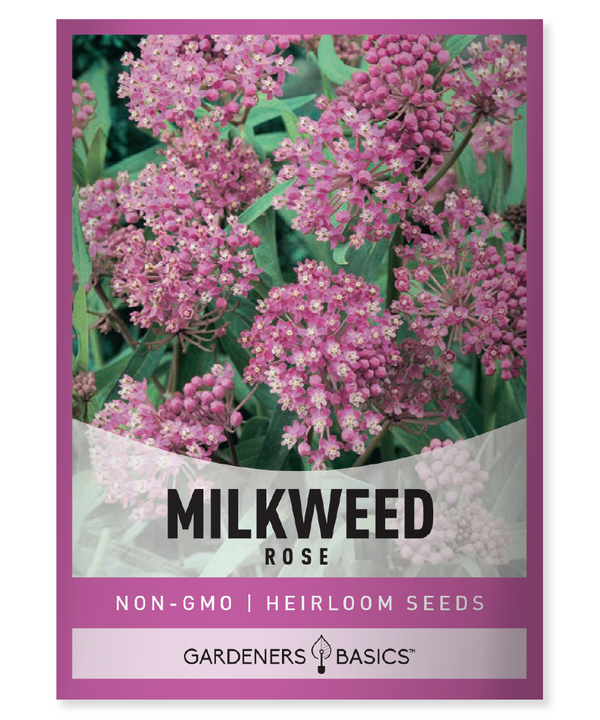
$2.49
Rose Milkweed Seeds - Heirloom, Non-GMO, Non-Hybrid, Open-Pollinated for Beautiful Pollinator-Friendly Gardens Enhance your garden with Rose Milkweed seeds (Asclepias incarnata), a stunning perennial favorite among butterflies, bees, and other pollinators. These heirloom, non-GMO, non-hybrid, open-pollinated seeds produce elegant clusters… read more
Transplanting Your Milkweed Seedlings
Once your milkweed seedlings have developed at least two sets of true leaves, they are ready for transplanting into larger pots or directly into the garden. This process allows your seedlings to continue growing without being restricted by the limited space in their initial seed trays or pots.
Transplanting into Larger Pots
- Fill larger pots with a high-quality potting mix that provides the necessary nutrients, moisture retention, and drainage for your milkweed plants.
- Gently remove the milkweed seedlings from their seed trays or small pots, taking care not to damage the roots. A small, narrow tool like a butter knife or plant label can help you lift the seedlings without causing harm.
- Plant each seedling into a larger pot, burying the stem up to the first set of true leaves. This helps promote the development of a strong root system and provides additional support for the growing plant.
- Water the transplanted seedlings well and place them in a sunny window or under grow lights.
Transplanting into the Garden
Before transplanting your milkweed seedlings into the garden, it's crucial to wait until the risk of frost has passed, as milkweed plants are sensitive to cold temperatures. To prepare your seedlings for outdoor conditions, follow these steps:
Common Milkweed Seeds
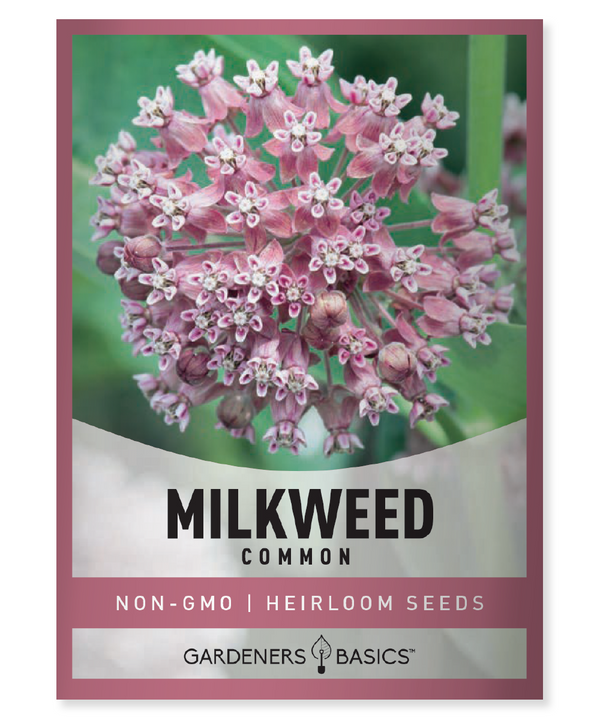
$2.49
Common Milkweed Seeds - Heirloom, Non-GMO, Non-Hybrid, Open-Pollinated Grow a butterfly and pollinator-friendly garden with our Common Milkweed Flower seeds! Perfect for attracting Monarch butterflies, bees, and other beneficial pollinators, these heirloom seeds are non-GMO, non-hybrid, and open-pollinated, ensuring pure,… read more
- Begin hardening off your seedlings by placing them outside in a sheltered location for a few hours per day, gradually increasing the time spent outdoors over a week or two. This process helps your seedlings acclimate to the outdoor environment, including fluctuations in temperature, light, and wind.
- Choose a sunny location in your garden with well-draining soil. Most milkweed species prefer full sun, but some varieties, like swamp milkweed, can tolerate partial shade.
- Space the milkweed seedlings 12-24 inches apart, depending on the milkweed species and variety. Proper spacing allows for adequate air circulation and minimizes the risk of disease and pest issues.
- Dig a hole slightly larger than the root ball of each seedling and gently place the seedling into the hole, covering the root ball with soil. Be sure to plant the seedlings at the same depth they were growing in their pots.
- Water the transplanted seedlings thoroughly and continue to provide at least an inch of water per week during the growing season. Regular watering is particularly important during the establishment phase, as it helps the plants develop a strong root system and promotes healthy growth.
Caring for Your Milkweed Plants
Once your milkweed plants are established, they require minimal care. However, there are a few things you can do to ensure their health and longevity:
- Keep the soil consistently moist but avoid overwatering, as milkweed plants are susceptible to root rot. This is particularly important for swamp milkweed, which prefers moist soil conditions. Monitor the soil moisture and water as needed to maintain a consistent level.
- Apply a layer of mulch around the base of your plants to help conserve moisture, suppress weeds, and regulate soil temperature. Organic mulches, like wood chips, shredded leaves, or straw, can also help improve soil fertility as they break down over time.
- If desired, apply a slow-release, balanced fertilizer to your milkweed plants according to the package instructions. While milkweed plants generally don't require heavy fertilization, a light application can promote robust growth and vibrant blooms.
- Regularly inspect your milkweed plants for signs of pests, like aphids or milkweed bugs, and manage them using non-toxic methods, such as manual removal or insecticidal soap. Remember to avoid using chemical pesticides, as they can harm the beneficial insects that rely on milkweed, like monarch butterflies.
- If you're growing tropical milkweed, consider cutting it back in the fall to encourage fresh growth and reduce the risk of disease. This also prevents the tropical milkweed from becoming too large, which can make it difficult for monarch caterpillars to navigate and find food.
Butterfly Milkweed Seeds
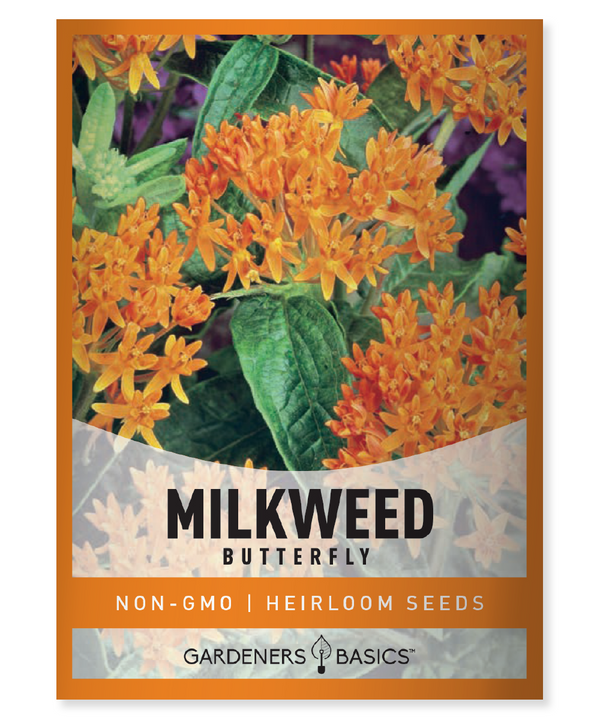
$2.49
Butterfly Milkweed Seeds - Heirloom, Non-GMO, Non-Hybrid, Open-Pollinated - Perfect for Pollinator Gardens Grow a vibrant and essential addition to your garden with Butterfly Milkweed seeds. Known for their stunning orange blooms, Butterfly Milkweed (Asclepias tuberosa) is a hardy perennial… read more
Enjoying Your Milkweed Garden
With your milkweed plants thriving, you'll soon see the arrival of beautiful monarch butterflies and other pollinators. Observing these creatures can be a rewarding experience, as you witness the important role your milkweed plants play in supporting local ecosystems. In addition to monarch butterflies, you may also attract other butterfly species, bees, and hummingbirds to your garden.
Remember to avoid using pesticides in your garden, as they can harm these beneficial insects. Instead, embrace the natural beauty and balance that your milkweed plants bring to your outdoor space. You may also consider planting additional native plants that provide nectar for adult butterflies and host plants for other butterfly species to further enhance your garden's attractiveness to pollinators.
In Conclusion
Starting milkweed seeds indoors is a rewarding process that allows you to support the monarch butterfly population while adding beauty to your garden. By following this comprehensive, step-by-step guide, you'll be well on your way to growing milkweed plants that provide food and habitat for these magnificent creatures. With some patience, dedication, and love, your garden will become a haven for monarch butterflies and other pollinators, and you'll enjoy the satisfaction of knowing you've played a part in protecting these beautiful and essential creatures. Now you've answered the question of can I start milkweed seeds indoors, will you give growing them a shot? Happy gardening!

 Frequently Asked Questions (FAQs) - Can I Start Milkweed Seeds Indoors
Frequently Asked Questions (FAQs) - Can I Start Milkweed Seeds Indoors
In this section, we'll address some of the most commonly asked questions about starting milkweed seeds indoors and growing milkweed plants.
Q: How long does it take for milkweed seeds to germinate?
A: Milkweed seeds typically germinate within 7-21 days, depending on the species, temperature, and moisture conditions. Some milkweed species may take longer to germinate, so be patient and keep the soil consistently moist to ensure successful germination.
Q: Can I grow milkweed in containers?
A: Yes, milkweed plants can be grown in containers, provided they have adequate space, drainage, and nutrients. Choose a large container with drainage holes and fill it with a high-quality potting mix. Be sure to water the plant regularly, as container plants can dry out more quickly than those planted in the ground.
Q: Is milkweed toxic to pets?
A: Milkweed plants contain toxins called cardiac glycosides, which can be harmful to pets if ingested. While cases of poisoning are relatively rare, it's essential to be cautious if you have pets that may chew on the plants. If you suspect your pet has ingested milkweed, contact your veterinarian immediately.
Q: Can I grow different milkweed species together?
A: Yes, you can grow different milkweed species together in your garden. Mixing different species can provide a range of colors and heights, creating an attractive display. Just be sure to consider the specific growing requirements of each species, such as soil type and sunlight needs, when planning your garden.
Q: Do I need to remove the fluff from milkweed seeds before planting?
A: While it's not necessary to remove the fluff, or coma, from milkweed seeds before planting, doing so can make it easier to handle the seeds and ensure a better contact with the soil. You can remove the fluff by gently rubbing the seeds between your fingers or using a fine-toothed comb.
Q: How can I collect milkweed seeds from my own plants?
A: Collecting milkweed seeds from your plants is easy. Wait until the seed pods turn brown and begin to split open, then carefully harvest the pods and remove the seeds. Separate the seeds from the fluff, store them in a cool, dry place, and use them for planting the following season.
Q: Should I deadhead my milkweed plants?
A: Deadheading, or removing spent flowers, is not necessary for milkweed plants, as they are typically self-seed and produce new plants the following season. However, if you want to prevent excessive self-seeding or encourage additional blooms, you can deadhead the plants by pinching off the spent flowers.
Q: When is the best time to plant milkweed seeds outdoors?
A: The best time to plant milkweed seeds outdoors is after the risk of frost has passed and the soil has warmed up. This typically occurs in late spring or early summer, depending on your region's climate. For a more precise planting time, consult local gardening resources or extension services for recommendations tailored to your area.
Q: How can I increase the germination rate of my milkweed seeds?
A: To increase the germination rate of your milkweed seeds, follow these tips:
- Use fresh, high-quality seeds. Older seeds or those stored improperly may have reduced viability.
- Cold stratify the seeds, if required for the species you're planting. This helps break seed dormancy and improve germination rates.
- Plant the seeds in a high-quality seed-starting mix, which provides the ideal conditions for germination.
- Maintain consistent moisture and temperature levels throughout the germination process.
Q: Can milkweed plants become invasive?
A: While some milkweed species can spread aggressively, they are generally not considered invasive when planted within their native range. To prevent excessive self-seeding, you can remove seed pods before they split open and release their seeds. It's also a good idea to plant native milkweed species, as they are better suited to local ecosystems and less likely to cause issues.
Q: Do milkweed plants attract any pests?
A: Milkweed plants can attract several insect pests, such as aphids, milkweed bugs, and milkweed beetles. However, these pests typically cause minimal damage to the plants and can often be managed through non-toxic methods, like manual removal or insecticidal soap. Keep in mind that milkweed plants also attract many beneficial insects, like monarch butterflies and other pollinators, so it's essential to avoid using chemical pesticides that can harm these important creatures.
Q: How can I encourage more monarch butterflies to visit my milkweed garden?
A: To attract more monarch butterflies to your milkweed garden, consider implementing the following strategies:
- Plant a diverse selection of milkweed species, which can provide a range of nectar sources and caterpillar host plants.
- Incorporate other native flowering plants into your garden, as these can provide additional nectar sources for adult butterflies.
- Provide a water source, such as a shallow dish or bird bath, where butterflies can drink and rest.
- Create sheltered areas using shrubs, trees, or tall perennials, which can offer protection from wind and predators.
- Avoid using pesticides in your garden, as these chemicals can harm butterflies and other beneficial insects.





